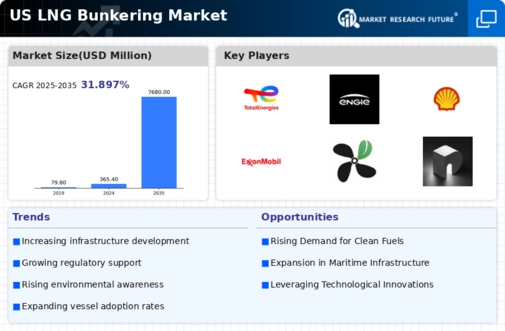Economic Viability of LNG as Fuel
The economic viability of LNG as a marine fuel is a significant driver for the The LNG bunkering market. With fluctuating oil prices, LNG has emerged as a cost-effective alternative for shipping companies. The price of LNG has been relatively stable compared to traditional marine fuels, making it an attractive option for operators looking to manage fuel costs. Additionally, the US has abundant natural gas resources, which further supports competitive pricing. As shipping companies seek to optimize their operational expenses, the adoption of LNG is likely to increase, thereby driving the growth of the lng bunkering market. This economic advantage positions LNG favorably in the competitive landscape of marine fuels.
Market Demand from Shipping Industry
The demand for LNG as a marine fuel is significantly influenced by the shipping industry's shift towards sustainable practices. Major shipping companies in the US are increasingly adopting LNG to meet their sustainability goals and comply with international regulations. The The LNG bunkering market is projected to grow by 20% annually as more vessels are converted to LNG propulsion. This trend is further supported by the International Maritime Organization's (IMO) initiatives aimed at reducing sulfur emissions from ships. As the shipping industry continues to embrace LNG, the demand for bunkering services is expected to rise, creating new opportunities for market players and enhancing the overall growth of the lng bunkering market.
Investment in Bunkering Infrastructure
Investment in bunkering infrastructure is crucial for the expansion of the The LNG bunkering market. The US has witnessed a surge in investments aimed at developing LNG bunkering facilities, driven by the need to support the growing fleet of LNG-powered vessels. According to the Department of Energy, the US is expected to allocate approximately $500 million towards enhancing LNG bunkering infrastructure over the next five years. This investment is likely to facilitate the establishment of new bunkering terminals and the retrofitting of existing facilities, thereby increasing the availability and accessibility of LNG as a marine fuel. Such developments are essential for meeting the rising demand from shipping companies seeking to comply with environmental regulations.
Environmental Regulations and Standards
The increasing stringency of environmental regulations in the US is a pivotal driver for the The LNG bunkering market. As the government enforces stricter emissions standards, the maritime industry is compelled to transition towards cleaner fuels. LNG, being a lower-emission alternative to traditional marine fuels, aligns with these regulatory frameworks. The Environmental Protection Agency (EPA) has set ambitious targets for reducing greenhouse gas emissions, which could lead to a projected growth of 15% in the adoption of LNG as a marine fuel by 2030. This regulatory push not only enhances the appeal of LNG but also stimulates investments in bunkering infrastructure, thereby propelling the lng bunkering market forward.
Technological Innovations in LNG Bunkering
Technological innovations play a vital role in shaping the The LNG bunkering market. Advances in LNG storage and transfer technologies are enhancing the efficiency and safety of bunkering operations. Innovations such as cryogenic transfer systems and automated bunkering solutions are being adopted to streamline processes and reduce operational costs. The US is witnessing a trend towards the implementation of digital technologies, including blockchain for tracking LNG supply chains, which could potentially increase transparency and reliability in the market. These technological advancements not only improve operational efficiency but also attract new investments, thereby fostering growth in the lng bunkering market.





















Leave a Comment